The Economics and Statistics Division maintains archives of previous publications for accountability purposes, but makes no updates to keep these documents current with the latest data revisions from Statistics Canada. As a result, information in older documents may not be accurate. Please exercise caution when referring to older documents. For the latest information and historical data, please contact the individual listed to the right.
<--- Return to Archive
For additional information relating to this article, please contact:
January 11, 2023NOVA SCOTIA POPULATION ESTIMATES BY COUNTY AND CENSUS SUBDIVISION - JULY 1, 2022 Statistics Canada has released estimates of the population by county as of July 1, 2022. Provincial population estimates for July 1, 2022 were released on September 28, 2022 and updated to October 1, 2022 on December 21, 2022. These population estimates should not be confused with Census counts. Estimates of the population adjust for net undercoverage from the Census as well as incompletely enumerated Indian reserves.
Between July 1, 2021 and July 1, 2022 Nova Scotia's population increased by 2.89% or 28,608 persons, reaching 1,019,725 as of July 1, 2022. Across Nova Scotia, all 18 counties reported population growth from July 1, 2021 to July 1, 2022. Halifax had the fastest growth at 4.50%, followed by Annapolis County at 2.79%. Growth was slower in Guysborough County as well as the four counties of Cape Breton Island.

Of the 28,608 persons added to Nova Scotia's population, Halifax accounted for the largest portion at 20,686. Kings, Colchester, Cape Breton and Lunenburg counties accounted for the next largest numbers of population increase.
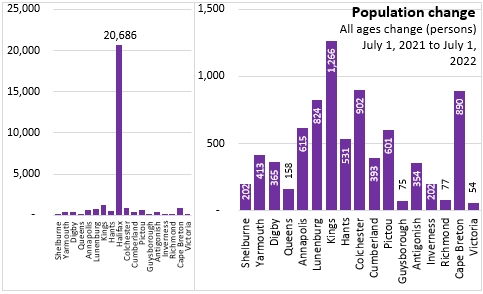
Halifax's population has risen to 480,523 or 47.1% of the provincial population as of July 1, 2022.
Cape Breton county's population was 98,808 and accounted for 9.7% of the provincial population. The other three counties on Cape Breton Island (Inverness, Richmond and Victoria) made up 3.3% of the provincial population (33,918).
Counties in the North Shore economic region (Colchester, Cumberland, Pictou, Guysborough, and Antigonish) had a population of 157,160 or 15.4% of the provincial total.
Counties in the Annapolis Valley (Annapolis, Kings and Hants) had 131,708 residents or 12.9% of Nova Scotia's population.
The counties of Southern Nova Scotia (Shelburne, Yarmouth, Digby, Queens and Lunenburg) had a population of 117,608 or 11.5% of the provincial total.

Outside of Halifax, Hants, Lunenburg, Colchester and Kings counties, most parts of the province experienced protracted periods of population decline. However, in recent years, population decline has stopped and reversed for all counties.
Compared against percentage growth rates dating back to 1987, the latest population growth was the fastest on record for all counties except Cape Breton (2019), Hants (1987) and Victoria (2020).
Note: vertical axis range from minimum to maximum for most counties are set to 8,000 except Cape Breton (24,000) and Halifax (160,000).

Components of county population change
Population estimates for counties change from one year to the next based on natural change (births less deaths), international migration (immigration, less net emigration, plus net change in non-permanent residents), net interprovincial migration (in-migrants from other parts of Canada to Nova Scotia less out-migrants from Nova Scotia to other parts of the country) and net intraprovincial migration (in-migrants from elsewhere in Nova Scotia less out-migrants bound for other parts of the Province).
All counties except Halifax reported more deaths than births between July 1, 2021 and July 1, 2022. The natural population decline was largest in Cape Breton (-737) and smallest in Hants county (-20). Halifax had a natural increase of 342.
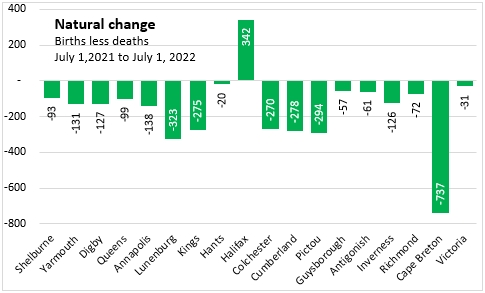
Immigration accelerated in the last year, adding 13,816 to Nova Scotia's population between July 1, 2021 and July 1, 2022. Immigration was concentrated in Halifax with 10,710 immigrants added to the population. The next highest numbers of immigrants added were in Cape Breton, Kings and Colchester counties.
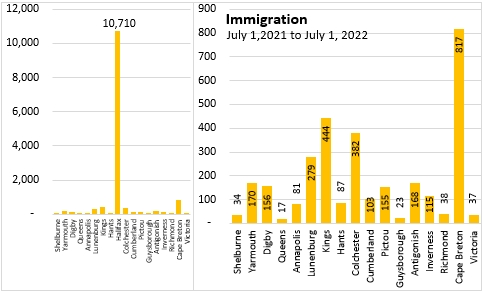
The flow of non-permanent residents (such as temporary foreign workers and international students) had been interrupted during the pandemic. However, in the last year there was a net increase of 3,816 non-permanent residents. Of these, the largest numbers were added to Halifax (1,901) and Cape Breton (1,242) counties. Victoria, Lunenburg and Pictou counties reported net declines in the number of non-permanent residents.
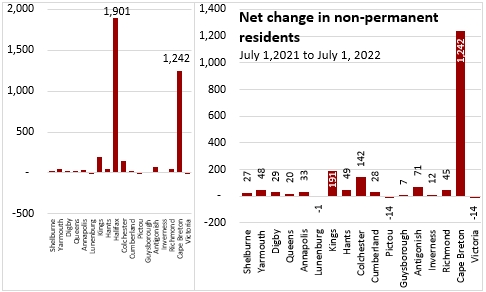
Overall net international migration contributed to population growth in every county. The province's overall net international migration of 17,319 was concentrated in Halifax (12,375). Victoria and Guysborough counties reported the least population gains from net international migration.
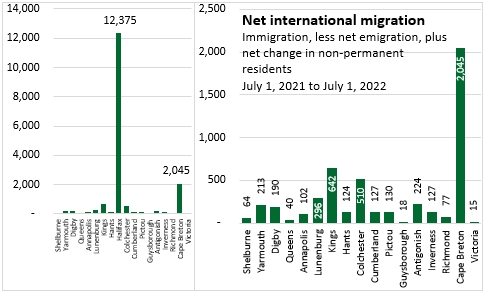
Net interprovincial migration has played an increasingly important role in Nova Scotia’s population growth since 2015. From July 1, 2021 to July 1, 2022 there was net interprovincial migration of +14,079 for the province as a whole (27,640 in-migrants less 13,561 out-migrants).
As with many other components of population change, net interprovincial migration was concentrated in Halifax with a net gain of 8,093 persons. Following Halifax, the largest net interprovincial migration gains were reported in Kings, Lunenburg and Pictou counties. All counties reported positive net interprovincial migration in the last year.
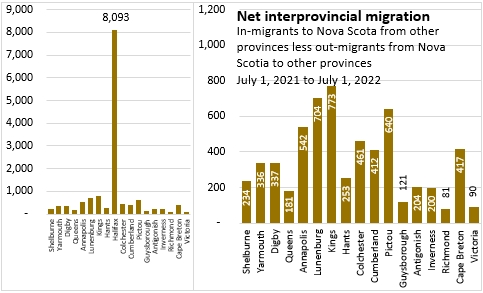
Net intraprovincial migration was negative for Halifax from July 1, 2021 to July 1, 2022 as more people moved out of the city to other parts of the province than moved into the city from elsewhere in Nova Scotia. Cape Breton county reported by far the largest net intraprovincial population decline. There were also modest net intraprovincial population declines in Shelburne, Yarmouth, Digby, Guysborough, Antigonish, Richmond and Victoria counties. Positive intraprovincial migration was reported in Queens, Annapolis, Lunenburg, Kings, Hants, Colchester, Cumberland and Pictou counties (as well as a marginal intraprovincial gain in Inverness).

Cities
Compared with other Census Metropolitan Areas, Halifax had the second fastest percentage population growth from July 1, 2021 to July 1, 2022 (following Moncton). Outside Halifax, Nova Scotia's population growth was 1.5% in the last year. Of the 9 provinces with Census Metropolitan Areas, New Brunswick reported the fastest population growth outside dense urban areas.
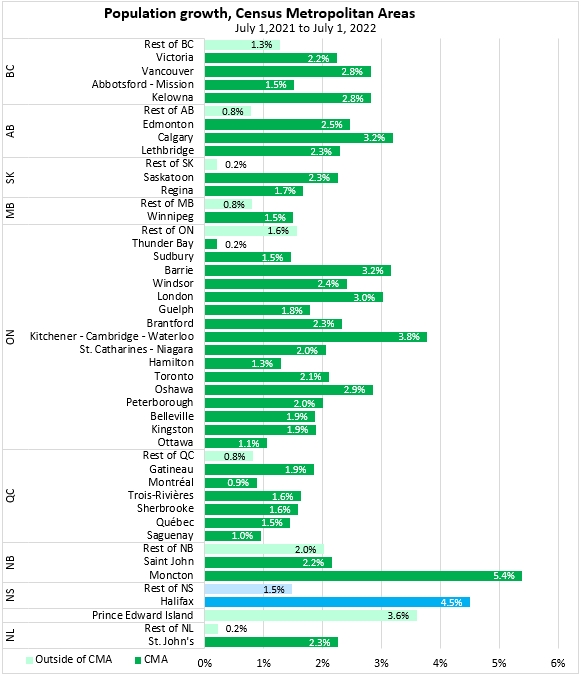
Age cohorts
Nova Scotia's overall median age declined from 44.9 years on July 1, 2021 to 44.2 years on July 1, 2021. Median ages were stable or down for most counties over the last year except for Queens and Victoria counties (which only reported increases of 0.1 years).
Over the last 5 years, median ages continue to climb for most counties, with the exception of a decline in Halifax and no change for Cape Breton county. Guysborough county reported the highest median age at 58.3 years old as of July 1, 2022. Halifax reported the lowest median age at 39.0 years.

Looking at the distribution of population across age groups and sexes, Nova Scotia’s population is concentrated in the 50 to 70-year-old age cohort. The distribution is similar between males and females.
Halifax in unique in having a higher share of population between the ages of 20 to 40. The share of population aged 50 and higher is lower compared to the provincial average.
The counties of Kings, Hants, Colchester, Pictou and Antigonish have population distribution similar to the provincial average, except for smaller portions aged 20-40.
Compared to the provincial average, a higher share of population in the 50 to 70 year old cohort was living in Shelbourne, Yarmouth, Digby, Queens, Annapolis, Lunenburg, Cumberland, Guysborough, Inverness, Richmond, Cape Breton, and Victoria counties. The share of population between 20 to 40-year-old cohort was also lower than the provincial average in these counties.
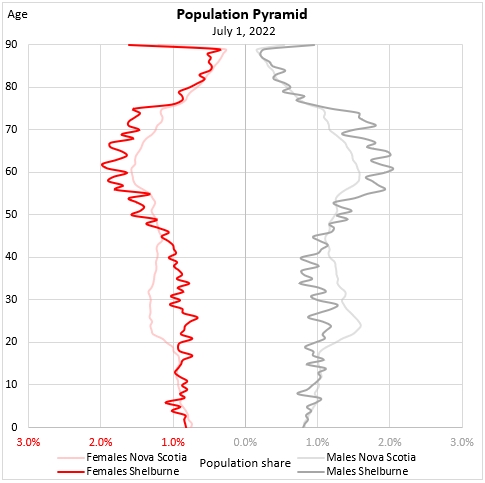
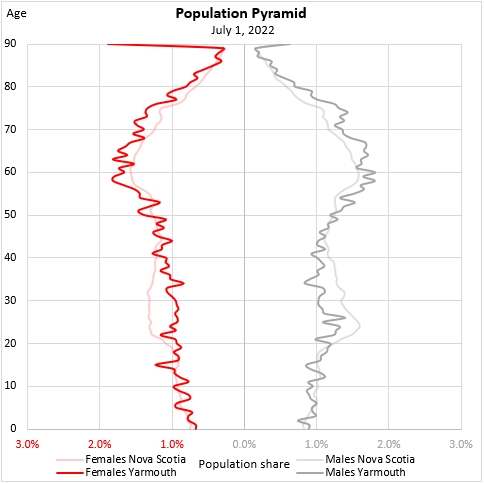



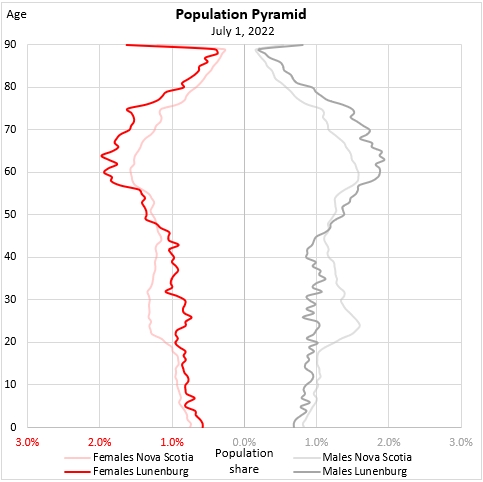

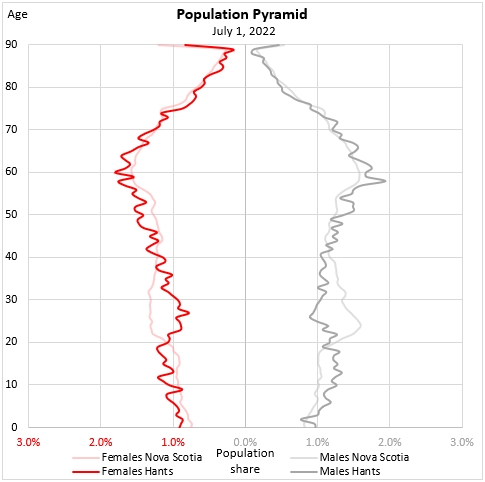
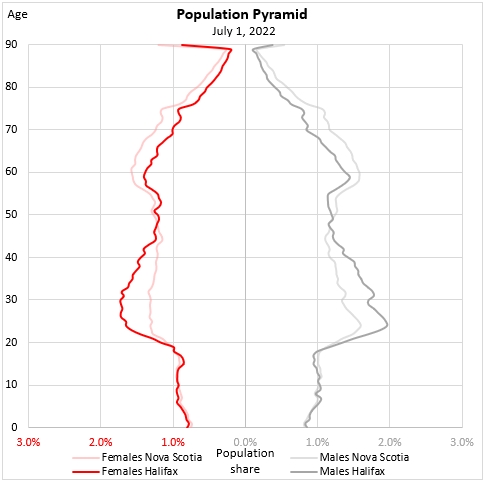
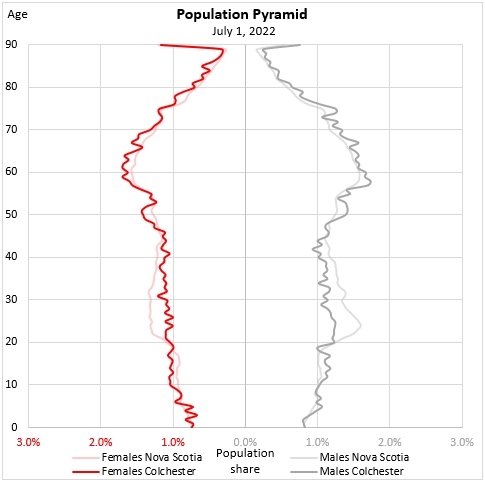
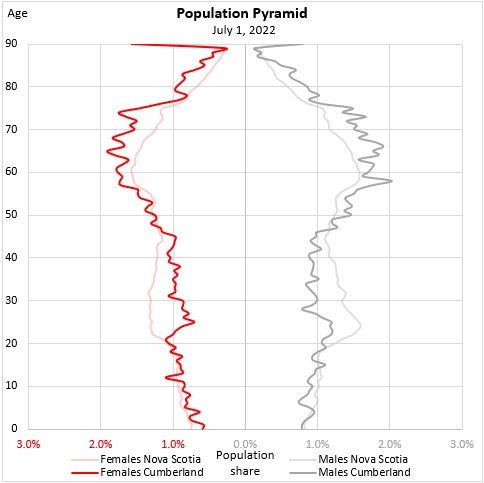
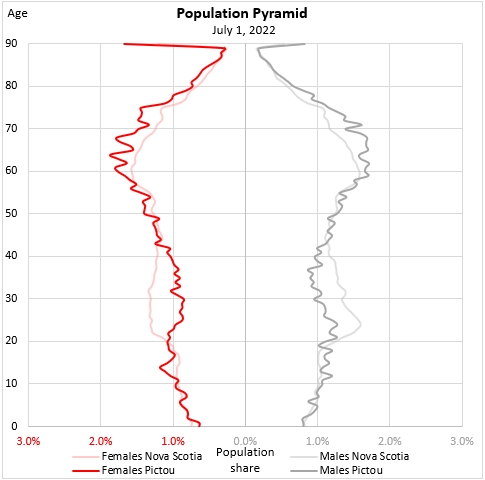
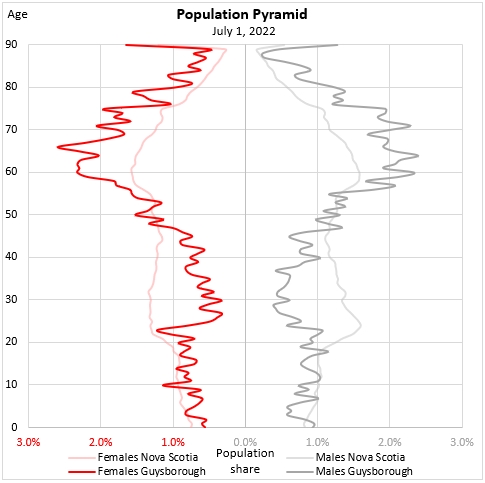

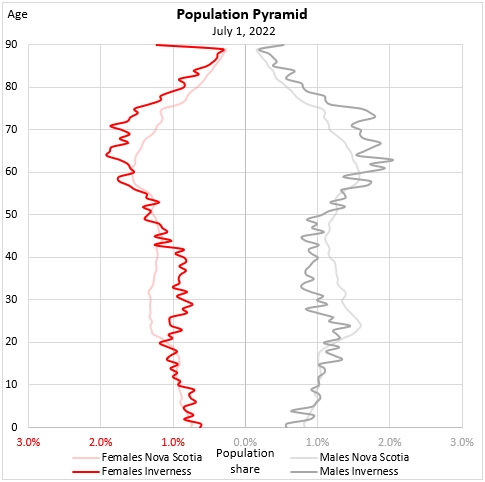
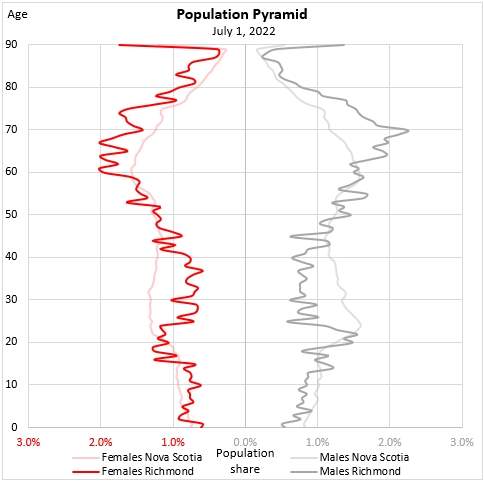

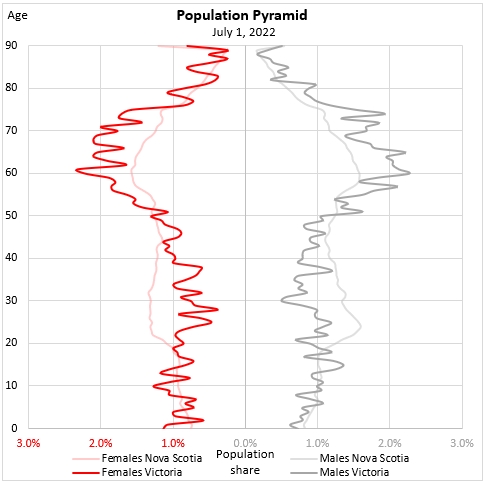
Census Subdivisions
Census subdivisions are towns, municipal districts, regional municipalities, Indian reserves and rural areas (identified as Subdivisions A, B, C, or D in their counties). A map of Nova Scotia's census subdivisions can be found here: Standard Geographical Classification, census division – census subdivision maps, Nova Scotia (PDF version, 4369.7 KB)
Note: all county scales are set to a range of 7,000 except Halifax and Cape Breton counties. All census subdivision scales are set to a range of 1,500 except East Hants, Halifax Regional Municipality and Cape Breton Regional Municipality.


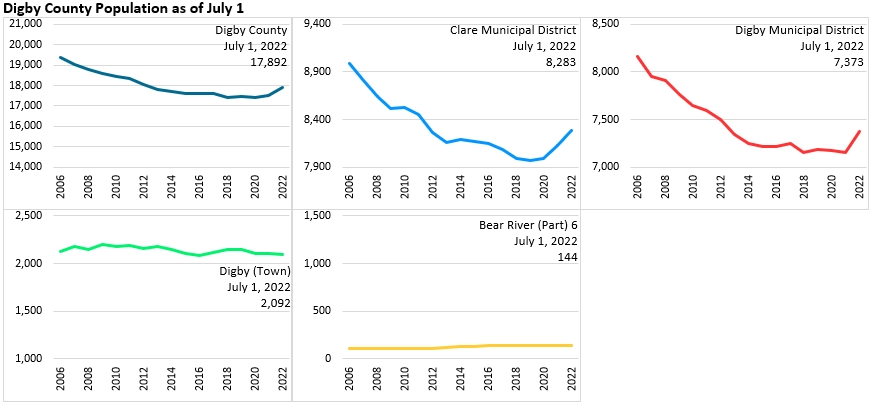
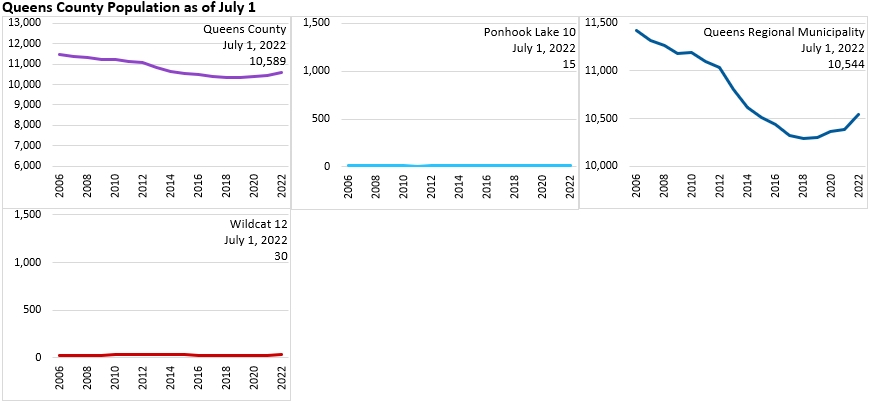
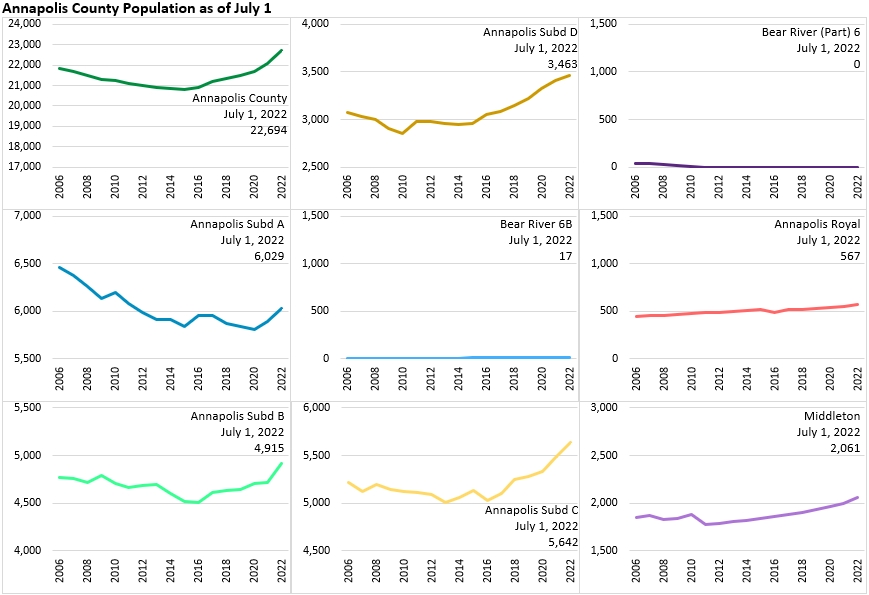
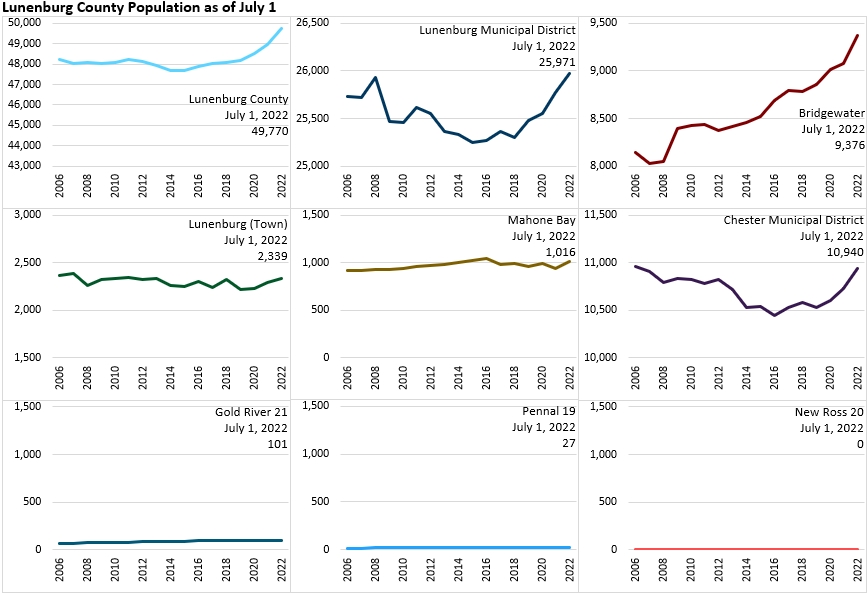

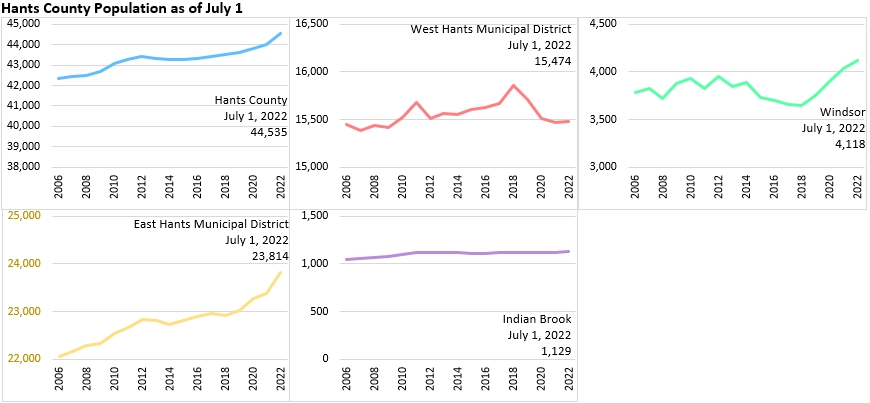
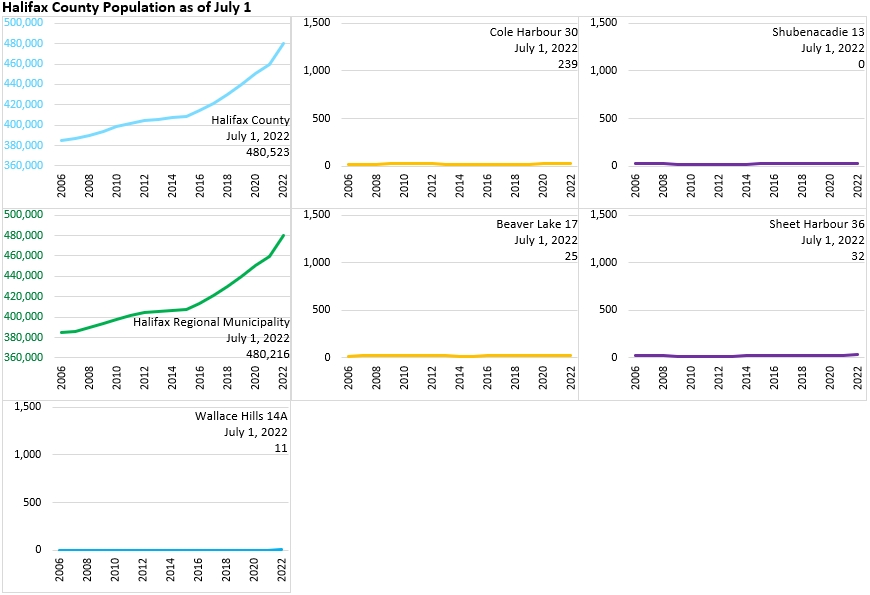
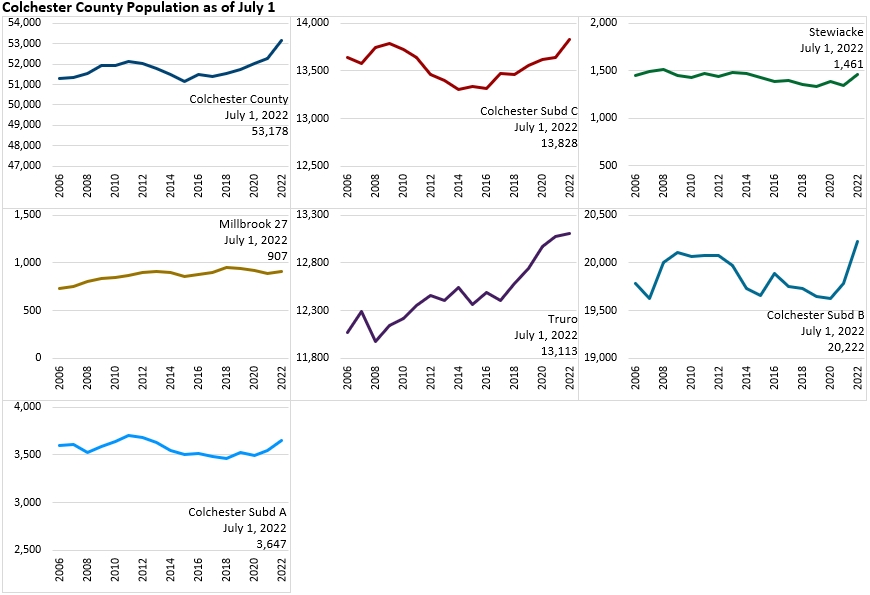
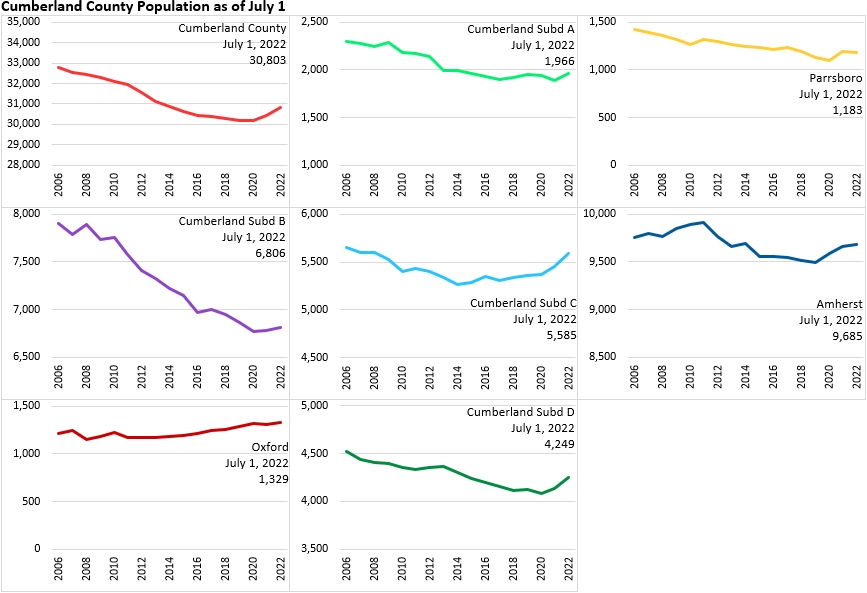
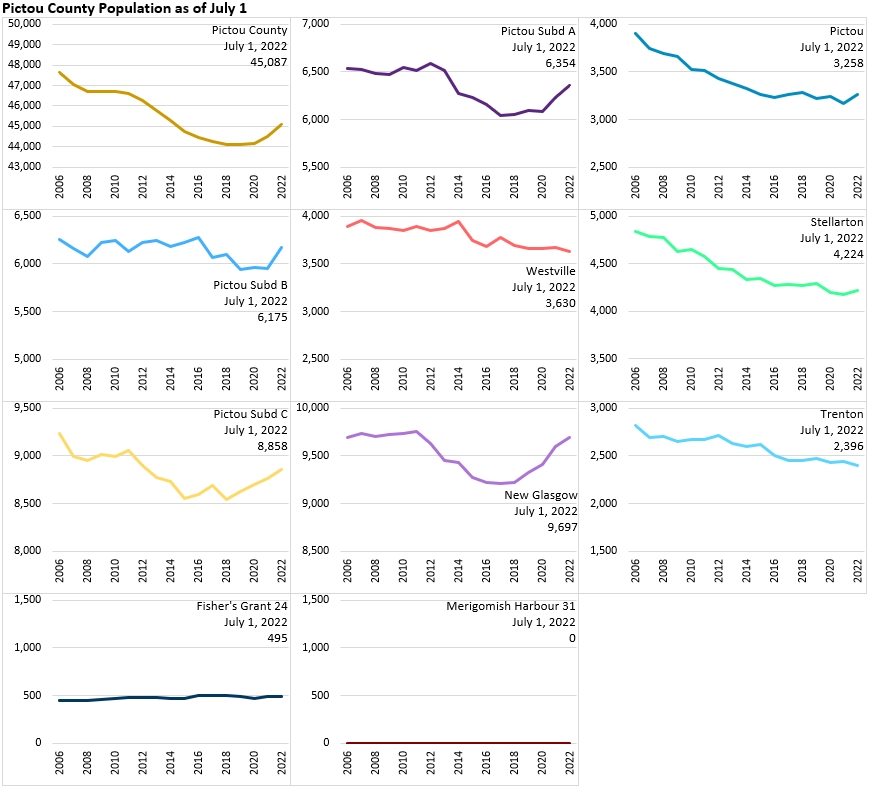
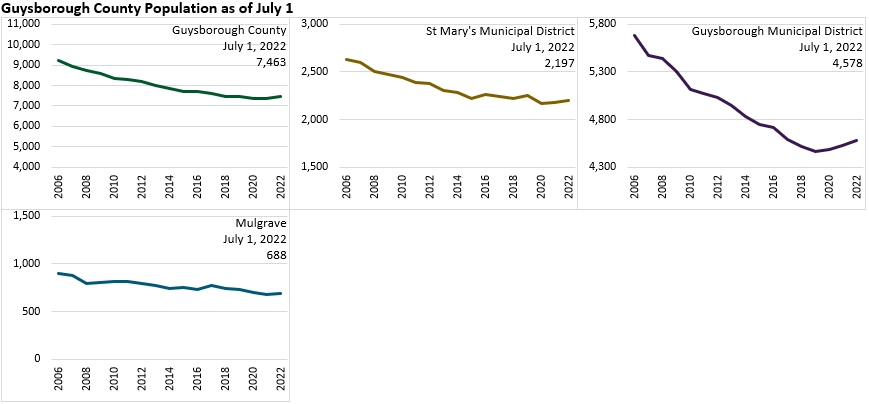

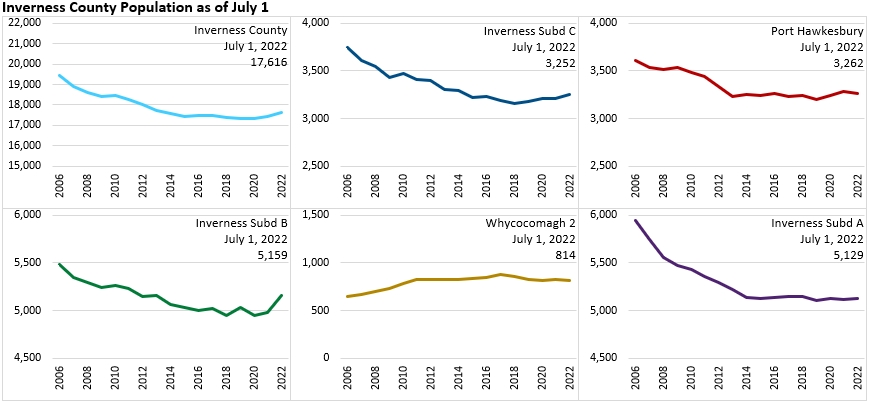
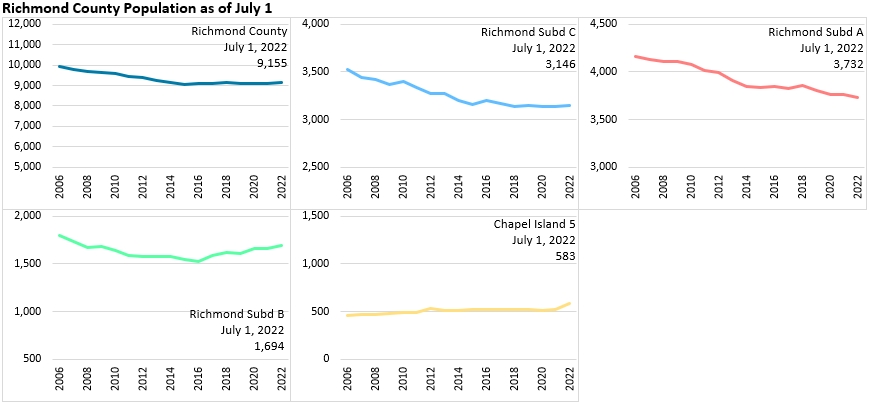
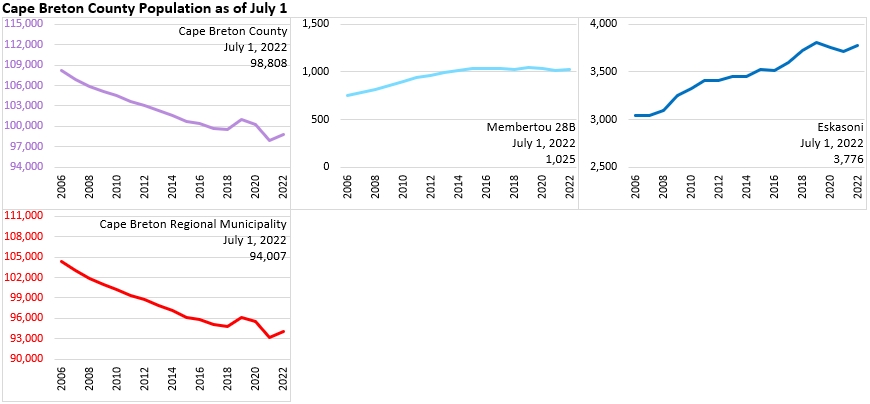
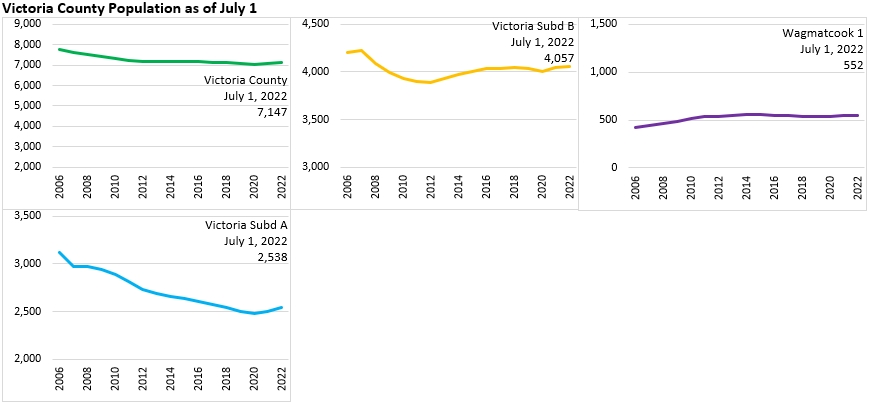
Sources: Statistics Canada. Table 17-10-0135-01 Population estimates, July 1, by census metropolitan area and census agglomeration, 2016 boundaries; Table 17-10-0139-01 Population estimates, July 1, by census division, 2016 boundaries; Table 17-10-0140-01 Components of population change by census division, 2016 boundaries; Table 17-10-0142-01 Population estimates, July 1, by census subdivision, 2016 boundaries; Standard Geographical Classification, census division – census subdivision maps, Nova Scotia (PDF version, 4369.7 KB)
<--- Return to Archive